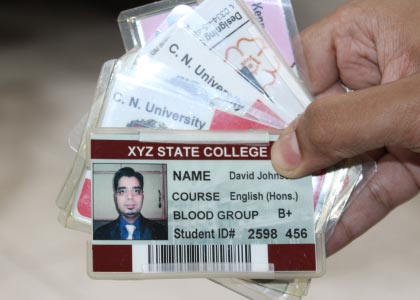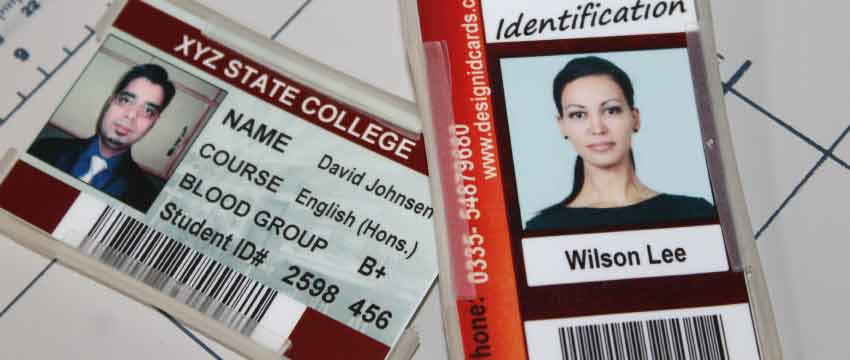Printing Student ID Cards
Here are some commonly used printing options for student ID cards:

-
Direct-to-Card Printing (DTC):
Direct-to-card printing is one of the most popular methods for producing ID cards. It involves printing the card design directly onto a blank PVC or composite card using a specialized ID card printer. DTC printers use a thermal transfer process that applies color or monochrome ink onto the card surface. This method allows for high-resolution printing and customization options like adding student photos and variable data.
-
Reverse Transfer Printing (Retransfer):
Reverse transfer printing, also known as retransfer printing, is a two-step process that offers superior print quality and durability. In this method, the card design is printed onto a transparent film, which is then thermally bonded to the ID card's surface. The transfer film ensures that the print is protected by a durable layer, resulting in vibrant colors, sharp details, and resistance to wear and tear. Retransfer printers are particularly suitable for high-security applications or when printing on uneven or non-PVC card surfaces.
-
Thermal Printing:
Thermal printing is a cost-effective and efficient printing method commonly used for printing monochrome or grayscale elements on ID cards. It uses heat-sensitive ribbons that are heated by the thermal printhead to transfer ink onto the card surface. Thermal printing is often employed for printing text, barcodes, and serial numbers on ID cards, providing clear and durable results.
-
Dye-Sublimation Printing:
Dye-sublimation printing is a process where a colored dye is transferred onto the card using heat and pressure. This method offers high-quality, full-color printing with smooth gradients and accurate color reproduction. Dye-sublimation printers are suitable for producing visually appealing ID cards with vivid graphics, photos, and intricate details.
-
Inkjet Printing:
Inkjet printing is a versatile printing option that uses liquid ink droplets to create images on the ID card. Inkjet printers for ID card production are equipped with specialized inks and print heads designed for precise and accurate printing. Inkjet printing allows for high-resolution color printing and is suitable for printing complex designs, photos, and fine details.
-
Laser Printing:
Laser printing is a non-contact printing method that uses a laser beam to generate an electrostatic charge on a drum or roller. This charged surface attracts toner particles, which are then transferred onto the ID card's surface and fused using heat. Laser printing is known for its fast printing speeds and high-quality text and graphics. It is commonly used for printing text and variable data on ID cards.
-
Offset Printing:
Offset printing is a traditional printing method commonly used for large-scale card production. It involves creating a printing plate with the card design and transferring the ink from the plate to a rubber blanket before applying it to the ID card surface. Offset printing provides high-quality, consistent results with precise color reproduction. It is often used for printing large quantities of ID cards in a single print run.
Designing Tools Available for Creating Student ID Cards
Several design tools are available for creating student ID cards, ranging from professional graphic design software to user-friendly online platforms. The choice of design tool depends on your familiarity with design software, the complexity of your design requirements, and your budget. Here are some commonly used design tools for creating student ID cards:

-
Adobe Photoshop:
Adobe Photoshop is a professional graphic design software widely used for creating and editing images. It offers a range of powerful tools and features that allow you to design ID cards with precise control over elements such as images, text, colors, and effects. Photoshop provides advanced capabilities for photo editing and manipulation, making it suitable for creating ID cards with high-quality student photos.
-
Adobe Illustrator:
Adobe Illustrator is a vector-based design software that focuses on creating scalable and precise graphics. It is ideal for creating ID card designs that require precise shapes, logos, and typography. Illustrator offers a wide range of tools for creating vector-based artwork, allowing you to create visually appealing and print-ready ID card designs.
-
CorelDRAW:
CorelDRAW is another popular vector-based design software that provides similar functionality to Adobe Illustrator. It offers a user-friendly interface and robust design tools for creating professional-grade ID card designs. CorelDRAW is particularly known for its flexibility and compatibility with various file formats, making it suitable for designing ID cards that require seamless integration with other software or workflows.
-
Canva:
Canva is an online design platform that offers a user-friendly interface and a wide range of pre-designed templates. It provides drag-and-drop functionality, making it accessible even for users with limited design experience. Canva offers a dedicated ID card template category with customizable elements, allowing you to easily create visually appealing student ID card designs without extensive design skills.
-
GIMP:
GIMP (GNU Image Manipulation Program) is a free and open-source image editing software that provides many features similar to Adobe Photoshop. It offers tools for image retouching, editing, and design. GIMP is a viable option if you are looking for a cost-effective solution for designing student ID cards with basic to intermediate design requirements.
-
Online ID Card Design Tools:
Various online platforms specifically cater to ID card design. These platforms provide pre-designed templates, customizable elements, and user-friendly interfaces to design ID cards online. Examples include IDCreator, EasyIDCard, and ID Card Workshop Online. These tools often offer features such as drag-and-drop functionality, photo uploading, and customization options to create ID cards quickly and easily.
Consider the complexity of your design requirements, the level of customization you desire, and your familiarity with design software when selecting a design tool. Additionally, ensure that the chosen tool supports the file formats and specifications required by your ID card printing process to ensure compatibility and optimal print results.